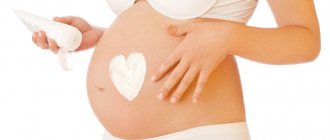Skin diseases during pregnancy
The content of the article
Types and reasons for changes:
- Dark spots
. Due to an increase in the level of pigment - melanin, dark spots appear on the skin. - Melasma
. A form of hyperpigmentation, also known as "mask of pregnancy". - Stretch marks
. They can appear by the third trimester and sometimes remain for life. - Pimples.
Even those with clear skin can develop acne during pregnancy, but some forms of treatment for this problem should be avoided by using medications prescribed exclusively by a gynecologist. - Phlebeurysm
. Pathology can develop, but varicose veins often go away after childbirth.
Pregnant woman
The long wait to meet your unborn child is coming to an end; the 40th week of pregnancy is the last for most women. Every day the expectant mother’s anxiety increases, and the long wait affects her mood and well-being. Women strive to give birth to a child as quickly as possible, so that pregnancy and painful contractions become a thing of the past. Every pregnant woman dreams of meeting her baby, wants to hold him to her breast and stroke his tender head.
Many women, especially first-time mothers, worry that labor will begin unnoticed, but such cases are extremely rare. A woman feels the onset of labor, feels regular contractions that repeat at certain intervals and gradually increase, the time interval between them shortens.
Contractions may be preceded by prenatal rupture of amniotic fluid, which is observed in a certain percentage of women in labor. After the water breaks, contractions may be quite weak or completely absent. Regardless of the intensity of contractions, the release of water is one of the signs of the onset of labor and requires immediate contact with specialists and the woman’s hospitalization in a maternity hospital or hospital, since when the water breaks, the integrity of the bladder is disrupted and the risk of microorganisms dangerous to the baby’s health entering the uterine cavity increases. It is important that after the water breaks, the baby is born within a maximum of 10-12 hours.
A pregnant woman must properly tune in to childbirth, concentrate on the desired result and believe in her own strength, and complete the task intended for her by nature. The right psychological attitude and theoretical knowledge will help a woman become a mother, successfully go through all stages of childbirth and hold the long-awaited child to her heart.
Hyperpigmentation
This is the appearance of dark spots on the face or other parts of the body. The phenomenon is caused by an increase in melanin production and goes away after childbirth, but can persist for several years.
An example of hyperpigmentation during pregnancy is melasma, known as “mask of pregnancy,” which is characterized by brown patches on the face, cheeks, nose, and forehead. To solve this problem, you need to consult a dermatologist.
To reduce stains, it is recommended to follow simple rules:
- limit your stay on the street during the period of solar activity from 10:00 to 14:00;
- in hot weather, use sunscreen with a factor of 30 or higher;
- wear a wide-brimmed hat.
Allergies and pregnancy: myths and reality
For many women, pregnancy is not only a long-awaited joy, but also a cause for concern. The information space is replete with articles about a variety of risk factors. Some of which really require attention, while others are nothing more than a myth.
The “danger” of allergies in a pregnant woman for the health of the fetus is one of the common causes of concern. How much concern is justified? Let's figure it out.
Myth No. 1: exacerbation of allergies during pregnancy - the risk of “allergization” of the child
The mechanism for the development of an allergic reaction is identical to that for any inflammation. Foreign object – production of antibodies – binding, removal and destruction of antigen – recovery.
In the case of allergies, class E antibodies serve as such “protection”, and some elements of the environment or food serve as a foreign object. Produced by the body after the first encounter with an “unpleasant” object, IgE is stored in the blood as “memory” cells and instantly initiates an “attack” (the release of histamine and similar substances) upon repeated encounter with the allergen.
However, due to their large size, class E antibodies are not able to penetrate the placental barrier, and the point of application of histamine and similar substances is only the “target” tissues of the allergic person (skin, respiratory tract and conjunctiva). Thus, neither IgE nor the “products” of its activity are capable of having any serious effect on the fetus.
Myth No. 2: Pregnancy causes an exacerbation of allergies.
Pregnancy is known for some “muffled” immune processes. Without a relative decrease in protective forces, the fetus would be rejected as a foreign object, but thanks to adrenal hormones this does not happen.
Normally, cortisol levels in a pregnant woman remain elevated until delivery. This weakens the reactivity of her immune system, not only against microorganisms, but also allergens, allowing her to “rest” from unpleasant allergy symptoms.
However, in approximately 10-30% of expectant mothers, allergies still make themselves felt. This may be due to a number of reasons, including genetic characteristics of the immune and hormonal status.
Myth No. 3: A blood test can predict possible allergies.
A general immunoglobulin E blood test serves to confirm the allergenic nature of existing symptoms and cannot be a risk marker.
Skin allergy tests can help predict the development of an allergic reaction in advance. The study involves applying allergens to a previously “scratched” area of skin with further assessment of the reaction. True, skin tests are not recommended during pregnancy, and the tests themselves can be false negative, due to the “work” of cortisol. While testing blood for class E antibodies to a specific allergen has no contraindications, and the high sensitivity of the test allows you to detect even the most minor changes. The level of immunoglobulin E to the allergen shows the level of “sensitization” - the body’s possible sensitivity to the allergen.
It must be said that to confirm the diagnosis, in combination with IgE, a general blood test with leukocyte count (focus on eosinophils) and eosinophil cationic protein (for hay fever) are indicated.
Obtaining increased values in the results is a justification for further examination, aimed either at searching directly for an individual allergen, or identifying a reaction to a specific group.
It is worth noting that the presence of an allergy comes as a “surprise” for some, since in a mild form the symptoms may be no different from skin diseases, acute respiratory viral infections, and even food intolerance. And due to the complex structure of some allergens, hypersensitivity, for example, to birch, manifests itself in a reaction when eating peaches.
Thus, an allergy as such is not capable of harming the fetus, normally should not appear during pregnancy, it is not possible to predict its occurrence, and a simple and effective blood test can help determine the existing reactivity.
Inflammation and itching
Itchy papules and plaques cause significant itching, burning or tingling. They vary in size and location. Most often the rash occurs on the stomach, legs, arms, chest or buttocks. They go away after childbirth.
Antihistamines or topical corticosteroids are used to treat inflammation and itching. In everyday life, it is necessary to use warm water when washing, apply cool compresses, wear loose and light clothing and avoid getting soap on skin that has rashes and age spots.
All medications are prescribed by a dermatologist, but they can be taken only after consultation with a gynecologist.
Pregnant woman
In the last weeks of pregnancy, the expectant mother strives to prepare her apartment or house as much as possible for the arrival of a new family member. Scientists call this sign of impending birth nesting syndrome. Many women observe signs of the syndrome from the thirtieth week of pregnancy, but at the 39-40th week nesting reaches its maximum point. Pregnant women strive to do general cleaning and repairs, re-stick wallpaper and purchase many new things that, in their opinion, are simply necessary in the house. After giving birth, many purchases cause confusion. The reason for this behavior is an increase in the level of adrenaline and norepinephrine in the body. These hormones are produced by the adrenal glands; they are necessary not only for the woman, but also for the baby to prepare for the upcoming birth.
Pimples
During pregnancy, hormonal changes occur that lead to acne. There are many ways to treat this problem.
It is necessary to follow general hygiene rules, such as washing your face with warm water and a mild product twice a day, treating the skin with non-aggressive products to prevent clogged pores.
During this period, you can use drugs that include benzoyl peroxide or salicylic, azelaic or glycolic acids.
During pregnancy it is prohibited:
- Carry out hormonal therapy
due to the increased risk of congenital pathologies of the fetus; - Use Isotretinoin
(a form of vitamin A, also known as Retinol). This can lead to disturbances in the mental and physical development of the unborn child. - Use Tetracycline
because it affects the formation of the fetal bone skeleton.
Pregnant woman at 37 weeks
As the due date approaches, pregnant women begin to notice the appearance of their precursors, that is, certain signs and changes that occur under the influence of hormones. A woman’s body is preparing to give birth to a child, progesterone gives way to the dominant role of the birth hormone estrogen, and the pregnant woman’s well-being changes.
From the 37th week, expectant mothers may observe the following changes:
- slight loss of body weight;
- reduction in abdominal volume;
- the appearance of training or “false” contractions and an increase in their intensity;
- discharge of mucus from the cervix.
The nature of the stool changes, it becomes weaker, aching pain in the lower back of varying intensity may appear, and the fundus of the uterus descends. The woman notes some signs on her own, others are observed by the gynecologist during a routine examination.
Precursors do not appear in all women. Some expectant mothers notice only some of the symptoms listed above, while others observe signs of impending labor not two or three weeks before the due date, but just a few hours. Both the appearance of precursors at the 37th week and their absence are normal and depend on the individual characteristics of the woman’s body.
This week, the female body is intensively preparing for the birth of a child. If the fetus is positioned correctly, head down, it gradually lowers, goes to the lower part of the uterus, presses it to the body and bends its limbs, intuitively taking the most comfortable position for passing the birth canal. The consequence of fetal movement is prolapse of the uterine fundus. The abdomen lowers, the pressure on the diaphragm decreases significantly, the pregnant woman can breathe easily, and the shortness of breath that plagued her in the previous weeks disappears. The pressure on the stomach also decreases, heartburn, a feeling of heaviness after eating and other unpleasant sensations disappear. Moving your baby can put pressure on your bowels and bladder. A pregnant woman at this stage often experiences the urge to urinate and may suffer from frequent loose stools. The reason for frequent bowel movements is not only the mechanical effect of the uterus on it, but also an increase in the content of estrogen in the body, hormones that promote the excretion of fluid. At the 37th week, the expectant mother can have bowel movements up to 3-4 times a day and at the same time observe significant dilution of the stool.
Vein changes
Varicose veins often develop during pregnancy.
Spider veins are small red vessels that most often appear on the face, neck and arms. These skin changes occur due to changing hormones and increased stress on the legs, vagina and rectum. They go away after childbirth.
To minimize the risk of developing pathology and alleviate symptoms, you need to take the following precautions:
- do not sit or stand for a long time, combine feasible physical activity with rest;
- spread your legs when forced to sit for a long time;
- Perform seated leg raises whenever possible;
- consult with your doctor to select a set of physical exercises to prevent blood stagnation in the vessels;
- monitor digestion, avoiding constipation.
40th week of pregnancy: how is the baby developing?
40 weeks – full-term pregnancy. The weight of a child born at this period ranges from 2,600 g to 4,400 g, and his body length is 48-53 cm. These indicators are very arbitrary, since at 40 weeks miniature babies weighing 2,600 g and real heroes are born, whose body weight approaches 5,000 g. The body length of newborns can also vary from 45 to 55 cm.
Most women give birth at 40 weeks. At this stage, the baby is completely ready for birth; it meets all the parameters of a full-term baby. Before birth, the baby presses its arms and legs closely to the body, bends its head as much as possible and presses against the exit of the uterus. This position makes it possible to pass the birth canal with the narrowest part of the skull. During labor, with each contraction, the child gradually moves downward; he does not move in a straight line, but makes helical-translational movements, as if screwing into the mother’s birth canal. As the newborn moves forward and his head descends completely, the cervix opens completely. This is followed by pushing, that is, contractions of the uterus that move the baby along the birth canal. The baby's head gradually appears, followed by his body. Childbirth is a complex mechanism that is aimed not only at the safe passage of the birth canal by the child, protecting him from accidental injuries due to increased pressure, but also at preventing ruptures of the woman’s soft tissues.
Other skin diseases in pregnant women
Less common skin conditions during pregnancy are pemphigoid rash and intrahepatic cholestasis.
- Gestational pemphigoid rash
is an autoimmune disease that appears in the second or third trimester or after childbirth. Symptoms of this condition include blisters on the abdomen or other parts of the body. Increases the risk of premature birth or having a low birth weight baby. - Intrahepatic cholestasis of pregnancy
is a liver condition that appears in the third trimester. It is characterized by severe itching on the palms of the hands, soles of the feet or torso, and occurs without a rash.
If unusual sensations on the skin, itching or rashes appear, you should consult a doctor to find out the cause of the phenomenon and begin treatment on time.
ONLINE REGISTRATION at the DIANA clinic
You can sign up by calling the toll-free phone number 8-800-707-15-60 or filling out the contact form. In this case, we will contact you ourselves.
39th week of pregnancy: what happens to the fetus?
At the 39th week, the child’s weight reaches 3,100-3,500 g, and his height is 50-52 cm. Height and weight indicators are very relative and can differ significantly. The baby is rapidly preparing for the most important test in his life - birth, which requires endurance and significant effort. During this period of pregnancy, the size and weight of the child’s adrenal glands, that is, the glands of the endocrine system, which are responsible for the human body’s response to stress factors, increase. It is the hormones adrenaline and norepinephrine produced by the adrenal glands that help the child adapt as quickly as possible to new temperature conditions, tactile, sound and light impulses.
All the baby's senses are developed at 39 weeks. Within a few moments after birth, the baby can focus his gaze, he reacts to bright light and moving objects, many scientists claim that newborns distinguish colors and see the faces of parents and doctors. In the last weeks of intrauterine life, the baby's hearing is also fully developed; after birth, he reacts to loud sounds and noise. A newborn baby can identify the basic shades of taste, recognize sour, bitter, sweet and salty.
In the womb, the baby is in an aquatic environment that minimizes contact. Immediately after birth, the baby experiences many tactile sensations; unlike intrauterine life, he feels the touch of his mother’s hands and diapers, towels, dressings and other materials. Babies especially like the touch of skin to skin, so in a modern maternity hospital, newborns are always placed on their mother’s stomach even before the umbilical cord is cut. The child adapts more easily to the new environment and feels protected. Placing the baby out has not only a psychological aspect, since it promotes the colonization of microorganisms from the mother’s skin onto the skin and mucous membranes of the baby, and increases his immunity.
Allergy treatment
It’s worth mentioning right away that allergies cannot be cured, you can only stop its acute manifestations. Most antihistamines are contraindicated during pregnancy, and those that can be taken can only be decided by a doctor, provided that the benefits of taking anti-allergy drugs outweigh the possible risk to the fetus. Therefore, you should not self-medicate an allergic reaction, especially expectant mothers.
Ideally, at the stage of pregnancy planning, a woman with allergies should visit an allergist in order to conduct a special diagnosis for potential allergens and, if possible, avoid contact with them.
But what to do if acute allergosis develops during pregnancy (for example, urticaria, rhinitis, conjunctivitis)? First of all, it is recommended:
- avoid contact with the suspected allergen;
- call a doctor;
- take a suprastin tablet (the drug is contraindicated in the first trimester).
Vasculitis58
Acne on the abdomen can be a manifestation of vasculitis. This is a dermatosis, in the pathogenesis of which the main role is played by nonspecific inflammation of the walls of the hypodermal and dermal blood vessels. The most common cause of their development is chronic and acute infections (bacterial, viral, fungal). For example, the pustular-ulcerative type of vasculitis is characterized by the appearance of vesiculopustules, similar to acne, but they quickly turn into ulcers. They are most often localized on the legs and lower abdomen. After their healing, hypertrophic scars may remain.
Factors causing allergies
Factors that cause allergies (allergens) for allergy sufferers can be completely harmless substances that healthy people do not attach importance to. First of all, allergies can be triggered by pollen, hair and fluff of pets, dust that accumulates in carpets, curtains, pillows (it is in it that microscopic mites that provoke allergies are found).
Some foods can also cause allergies: citrus fruits, seafood, exotic fruits, red vegetables, fruits and berries. Poisonous insects are also dangerous for allergy sufferers: bees, wasps, bumblebees and others. In addition, allergies can result from living in an environmentally unfavorable area, exposure to industrial hazards, household chemicals, medicinal and decorative cosmetics, and, of course, medications.
And, speaking of allergies, we must not forget about the influence of severe stress and psycho-emotional experiences on an “inadequately tuned” immune system.









